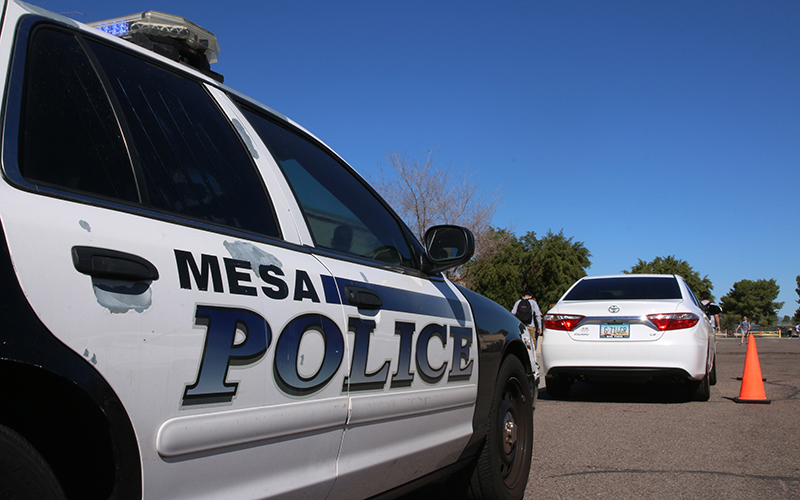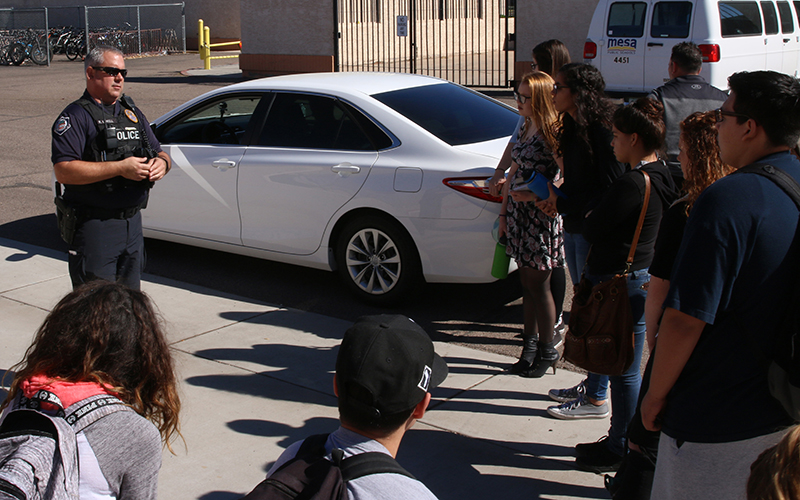
As part of a driver’s education class at Mountain View High School, Mesa police officer Ryan Lovell shows students mock traffic stops. The reinactments are meant to teach students the do’s and don’ts of traffic stops. (Photo by Blake Hemmel/Cronkite News)
PHOENIX – Arizonans taking the driver’s test this spring will answer questions about how to behave during routine traffic stops in a move to improve safety for drivers and law-enforcement officers.
Arizona lawmaker Reginald Bolding and community leaders are drafting recommendations for the written tests to offer clear, consistent standards in a state where expansive gun laws can risk confrontations, Bolding said.
The written test questions will help drivers understand “what to do when stopped by a police officer but also what their rights are if they feel they’re being discriminated against, if they were stopped wrongfully, or if they think the interaction between themselves and the officer is one in which they feel is not professional,” Bolding said.
The Arizona Department of Transportation is drafting the questions that will be on the test by March.
“I asked 20 different people what you should do when you’re stopped by police officers and I got 20 different answers,” said Bolding, a Democrat who represents the south Phoenix area. “Then, I reached out to ten different police officers and asked what their recommendations were and I got ten different answers.”

Ryan Lovell, a Mesa police officer, gives tips to high school students at Mountain View High School in Mesa about what to do when pulled over by a police officer. (Photo by Blake Hemmel/Cronkite News)
Bolding said police officers’ behavior at traffic stops is also important.
“In addition to ensuring that drivers understand the recommendations, it’s important that officers understand that they play a major role,” Bolding said. “We are also looking at recommendations for police officers when they are approaching a situation,” he said. (The Phoenix Police Department has a motorists’ guide to how officers will interact with drivers at a traffic stop.)
Mesa police officer Ryan Lovell this week provided pointers to driver’s education students at Mountain View High School on what to do if they’re pulled over.
“I learned that if it’s at night, you should roll down your window and turn on the lights so that the officer can see what you are doing,” said Samantha Chow, a sophomore at the Mesa high school. “Keep your hands at ten and two and just be nice to the officer,”
Jim Faul, who teaches driver’s ed courses at the school, said Arizona’s expansive gun laws, including concealed-carry laws that allow gun owners to place their guns in a vehicle glove compartment or under a car seat, means drivers need to act in a way that is safer for them and police officers.
“A lot of people know they are supposed to give the officer their registration, proof of insurance and license or permit and they usually reach for that in the glove compartment,” Faul said. “But with our laws on guns, that’s not what officers want you to do first,” Faul said. “They want you to keep your hands visible and roll the window down.”
Bolding said officer-involved shootings across the country, including those of drivers at traffic stops, show the need for an updated driver’s test.
Bolding said he pressed for recommendations for drivers carrying a handgun or other weapon, such as where a driver’s hands should be placed or when it’s appropriate to turn on the vehicle’s dome light.
“No one should ever leave a traffic stop in a body bag,” Bolding said. “I recognize that this won’t solve all officer-involved shootings…but I hope that this could potentially save a life or more by giving recommendations on what to do.”